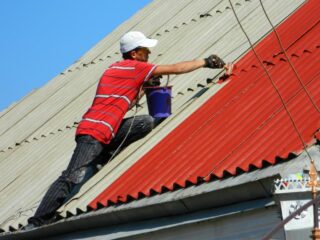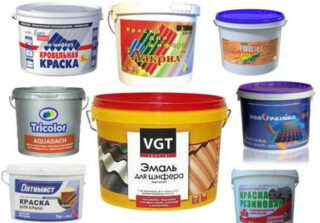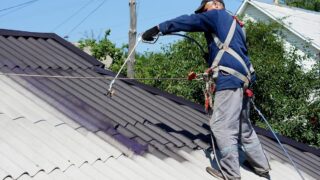Slate paint helps to maintain its performance for a long time and increase its service life. By painting, you can revive old material, give a beautiful look to a fence or roof of a house. To do this, you need to imagine which composition is better to purchase for a specific task.
Why paint slate

Painting the slate helps to improve the appearance of the roofing material and protect it from external factors. Due to the porous structure, products are prone to the appearance of microcracks, into which moisture can easily penetrate. In winter, it freezes and begins to deform the structure of the material. Similar processes begin if lichens and mosses settle in the cracks. Using rubber slate paint will help prevent this problem. The composition forms a strong film on the material, which serves as a barrier to moisture and parasites. This protects the slate from deformation, due to which its service life will be long. Moss, fungus or other harmful microorganisms will not settle on the treated roof. The surface turns out to be smooth, due to which precipitation comes off it faster.
Modern paints do not wash off after a few rains and perform their protective function for years. However, coverage needs to be updated periodically. How often you need to do this is indicated on the packaging of a particular paint. The data on the consumption of the composition are also given there. Do-it-yourself periodic painting of the slate will help the old coating look like new.
Types of slate paints

There are several types of slate paint, differing in their composition. The most common group is acrylic-based dyes, characterized by a rich color. Moreover, they are matte and with a certain degree of gloss.
There are the following groups of paints suitable for slate:
- Water-based acrylic products containing latexes, pigments and processing aids (e.g. anti-freeze). Such products are non-toxic, do not have a pronounced odor, and do not let moisture into the thickness of the material. They are easy to work with and do not require the use of a solvent. Sometimes it is practiced to dilute such a composition to obtain a primer. The drying time of the applied layer is up to 2 hours, and it must be renewed every 5 years. Thanks to antifreeze additives, the frost resistance of the slate increases. One of the varieties of these paints is rubber, which has a thick consistency and forms a very strong film that does not allow water to pass through. Due to its good adhesion to porous materials and the ability to seal small (up to 1 mm) cracks, it is recommended for use in slate.
- Paints with acrylic on organic solvents (usually white spirit is used) form a durable water-repellent film, hold well, are distinguished by rich color and UV resistance. They have a pungent smell, but when working outdoors, this will not be particularly annoying. The more acrylic resin in the composition, the more pronounced the gloss of the painted surface.
- Silicone products, distinguished by their durability (10-15 years) and capable of sealing cracks up to 2 mm, prevent the growth of fungi and other pests in the pores of the material and on its surface. The coating is elastic and durable. You can do without a primer when using such a paint.
- Alkyd compounds containing an organic solvent.They dry quickly, adhere well to slate, are resistant to moisture, and form an elastic film. The coverage needs to be renewed every 5 years. The product can be applied without a primer.
- Polymer compositions of the "Liquid Plastic" type, which include a solvent. When it evaporates as the layer dries, the paint forms a polymer film that can be either glossy or matte. The formulations are chemically inert, dry quickly, and create an excellent moisture barrier. They need to be updated every 10-15 years. If other paints need to be applied to the surface at temperatures above +5 degrees Celsius, then polymer products can be used when the mercury column drops slightly below zero (but not below -10 degrees). At the same time, the dried coating is frost-resistant. It is not required to prime the surface before application. On sale there are coloring compositions based on polystyrene, polyurethane and vinyl bases.
The most common colors are brown, red and green. They are presented in many colors. A specific product can have from 3-4 to several dozen shades.
If the homeowner wants to paint the slate in a not very popular color (for example, orange), and the selected product of this tone is not in the catalog, you can use tinting. Many manufacturers of paint and varnish materials provide the service of coloring their products in any shade included in a certain palette (for example, NSC). In an industrial setting, the procedure is carried out on an apparatus using a tinting paste. You can also implement it at home. At the same time, paste is added to the paint of a neutral tone and everything is thoroughly mixed. Instructions for the use of tinting products are provided on the packaging.
Slate staining technology

Painting flat slate is an easy process due to the simple configuration of the material. In order for the coating to hold well and last a long time, the surface requires careful preparation. You need to paint slate with your own hands in the warm season and in dry weather. It is important that precipitation does not foreshadow the day following the procedure. The process does not imply cutting the material, but safety precautions require work in the appropriate equipment: a respirator, goggles and overalls in order to exclude contact with asbestos dust, which has carcinogenic properties.
First, the surface is cleaned of dust, moss, branches and other plant material. This should be done in dry weather, since slate wet after rain has increased fragility. The fastest method is to use a jet of water (the pressure should not be strong, otherwise the material will break). It is possible to use mechanical methods, the safest of which is working with a wire brush. With good skill in working with a grinder, you can use it by placing a grinding attachment. The disadvantages of this method are the release of asbestos dust into the space and the need to control the pressure so as not to damage the material.
The surface is treated with an antiseptic. It can be a special composition for slate or a product for a wide range of uses. It can be applied with a brush, roller or spray. After the antiseptic has dried, the surface is treated in a similar way with a water-repellent compound.
If a particular paint requires a primer, this process should not be neglected. It provides evenness of the coating and adhesion strength, eliminates small cracks. Some colorants can be used as a primer by diluting them with a solvent. When applying, you must adhere to the manufacturer's recommendations.
It is best to spray the paint directly with a spray gun, and use a brush to work with hard-to-reach areas. It is not worth using a roller, since it is problematic for them to provide a uniform coating for corrugated slate. After the first layer has dried, the second, finishing layer is applied. Attention is paid to corners, end pieces and other structural elements.For 1 m² of area, 100-200 g of the composition is consumed. When purchasing, it is better to purchase it with a certain margin.
When working with new slate, it is often recommended to break the process into parts: carry out antiseptic treatment on the ground, and painting on the roof. This is due to the fact that when installing colored sheets, damage is possible. When working on a roof with a simple structure and a small area and slope, this risk is reduced. Some craftsmen prefer to paint the sheets on the ground, and if damage occurs during installation, fix them already on the roof.
Old roofs are often cracked, making it dangerous to sit on them. Before painting, the surface must be examined for integrity violations. It happens that some sheets require replacement after many years of operation. The cracks are covered with fabric tapes soaked in waterproof glue. After it dries, you can proceed to further work.








